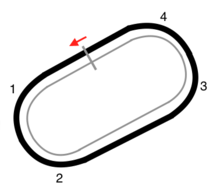1968 Southeastern 500
| Race details[1] | |||
|---|---|---|---|
| Race 5 of 49 in the 1968 NASCAR Grand National Series season | |||
 Layout of Bristol Motor Speedway | |||
| Date | March 17, 1968 | ||
| Official name | Southeastern 500 | ||
| Location | Bristol International Speedway, Bristol, Tennessee | ||
| Course |
Permanent racing facility 0.500 mi (0.800 km) | ||
| Distance | 500 laps, 250.0 mi (400.0 km) | ||
| Weather | Cold with temperatures approaching 57 °F (14 °C); wind speeds up to 14 miles per hour (23 km/h) | ||
| Average speed | 77.247 miles per hour (124.317 km/h) | ||
| Attendance | 19,800[2] | ||
| Pole position | |||
| Driver | Petty Enterprises | ||
| Most laps led | |||
| Driver | David Pearson | Holman-Moody | |
| Laps | 176 | ||
| Winner | |||
| No. 17 | David Pearson | Holman-Moody | |
| Television in the United States | |||
| Network | CBS | ||
| Announcers | Bud Lindemann | ||
The 1968 Southeastern 500 was a NASCAR Grand National Series (now Sprint Cup Series) event that was held on March 17, 1968, at Bristol International Speedway in Bristol, Tennessee. Highlights of this racing event were later shown on the classic Car and Track television show on most CBS stations.
The transition to purposely-built racers began in the early 1960s and occurred gradually over that decade. Changes made to the sport by the late 1960s brought an end to the "strictly stock" vehicles of the 1950s; most of the cars were trailered to events or hauled in by trucks.
Summary
A total distance of 500 laps were accomplished at this event; with Bobby Allison acquiring the last-place position due to stock car engine problems on lap 41. While the first 100 laps of this race event were a David Pearson and Richard Petty show, it would be LeeRoy Yarbrough would compete against Pearson in the closing laps of this event. All 36 of the qualifying drivers were born in the United States of America. Clyde Lynn's incredibly disappearing tail end of his vehicle eventually stalled his racing hopes on lap 445. Henley Gray would become the lowest-finishing driver to actually complete the event; albeit more than 100 laps behind the lead-lap competitors.[2]
David Pearson would best Richard Petty by a distance of three seconds after racing at each other's throats for more than three hours. More than 19,000 ardent NASCAR followers would see a race marred by eleven caution flags for a duration of 81 laps. Richard Petty's qualifying speed of 88.582 miles per hour (142.559 km/h) would see him blaze through the field during solo qualifying runs. Cale Yarborough would spend some time as the leader of the race before an incident involving the back of his vehicle would end his day of racing on lap 237.[2] Roy Trantham would make his introduction into the NASCAR Cup Series scene in this race while Serge Adams would exit stage left from NASCAR racing after the conclusion of this event.[3]
Individual race earnings ranged from the winner's share of $25,415 ($173,235.45 when adjusted for inflation) to the last-place finisher's portion of $500 ($3,408.13 when adjusted for inflation). NASCAR handed out a grand total of $86,285 to all the competitors who qualified for this racing event ($588,141.68 when adjusted for inflation).[4]
Top ten finishers
- David Pearson (No. 17)
- Richard Petty (No. 43)
- LeeRoy Yarbrough (No. 26), 1 lap behind
- Darel Dieringer (No. 22), 8 laps behind
- Bobby Isaac (No. 71), 9 laps behind
- Bud Moore (No. 1), 9 laps behind
- Jack Ingram (No. 09), 19 laps behind
- Bill Champion (No. 10), 31 laps behind
- Elmo Langley (No. 64), 32 laps behind
- Earl Brooks (No. 2), 33 laps behind
References
- ↑ Weather information for the 1968 Southeastern 500 at The Old Farmers' Almanac
- 1 2 3 1968 Southeastern 500 racing information at Racing Reference
- ↑ Introductions and departures from NASCAR after the 1968 Southeastern 500 at Race-Database
- ↑ 1968 Southeastern 500 prize winnings information at Fantasy Racing Cheat Sheet
| Preceded by 1968 Daytona 500 |
NASCAR Grand National Season 1968 |
Succeeded by 1968 Richmond 250 |